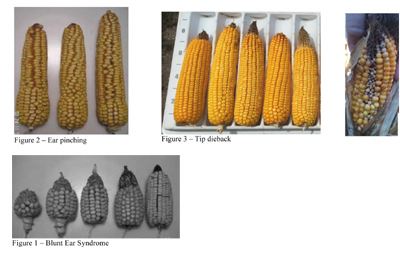|
Channel Field Check Up
KAYLISSA HALTER
ROBINSON, ILL.
Many factors can affect kernel development and ultimately corn yield potential, including available plant nutrients, pest and disease pressure, weather stresses, herbicide applications and agronomic practices. Corn yield potential is determined early in development and can be negatively impacted before pollination.
Knowing and recognizing which factors impact ear development will help you better prepare for next year and make corrections, if need be, to your agronomic practices.
Blunt Ear Syndrome
Kernel development is normal at the ear base, but the kernel number per row is usually half the normal length. Cob and kernel development simply stop halfway up the ear. Blunt ears typically have a barren tip as well. The true cause of blunt ear syndrome is unknown, but thought to be caused by chilling injury or post-emergence growth regulator herbicide applications around V7 to V10.1

Ear pinching
Kernel row number becomes reduced as you move up the ear. (For example, the base could be 20 kernel rows but only eight kernel rows per ear at the tip.) Ear length is typically normal. Similar to blunt ear syndrome, severe stress around V7 to V10 causes the kernel row to “pinch” together. Late post-emergence ALS inhibitor herbicide applications can cause ear pinching.
Tip Dieback
Kernel abortion occurs at the tip of the ear. Unfertilized ovules and aborted kernels appear shriveled and dried up. Aborted kernels may have a slight yellow color. Drought stress, nitrogen deficiency, high temperatures, foliar disease or cloudy weather during early kernel set causes tip dieback.2
Zipper Ear
There are missing kernel rows on the underside of the ear due to kernel abortion. Zipper ear often causes the ear to bend and resemble a banana. Zipper ears can be caused by drought stress, defoliation after pollination and herbicide damage to reproductive tissues (pollen, silks, ovules) from misapplications beyond labeled crop height.
As a farmer, you strive to put your best foot forward to prepare your crop for success. So, next time you see odd ears, do some investigating or call your local agronomist to find what caused the abnormal development and if possible, make corrections.
1Nielsen, R.L. (Bob). 2003. Blunt Ear Syndrome in Corn. Purdue University. Corny News Network. [Online]. Available at http://www.agry.purd ue.edu/ext/corn/news/art icles.03/beerca nears-0812.html.
2Channel. 2014. Abnormal Corn Ears. Monsanto Technology Development & Agronomy.
3Thomison, P and A. Geyer. 2007. Abnormal corn ears ACE-a. The Ohio State University. ∆
KAYLISSA HALTER: Channel Agronomist

|
|